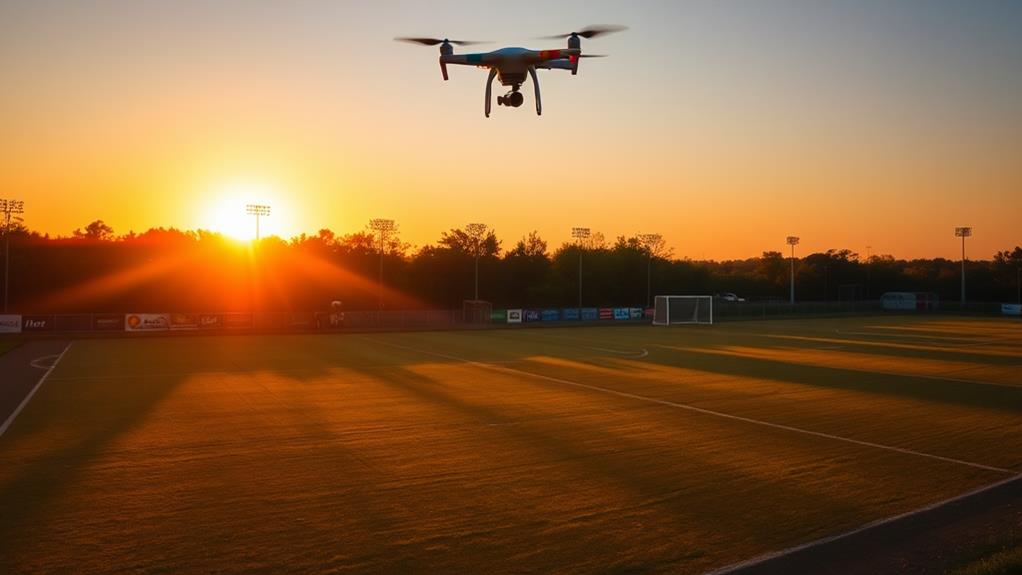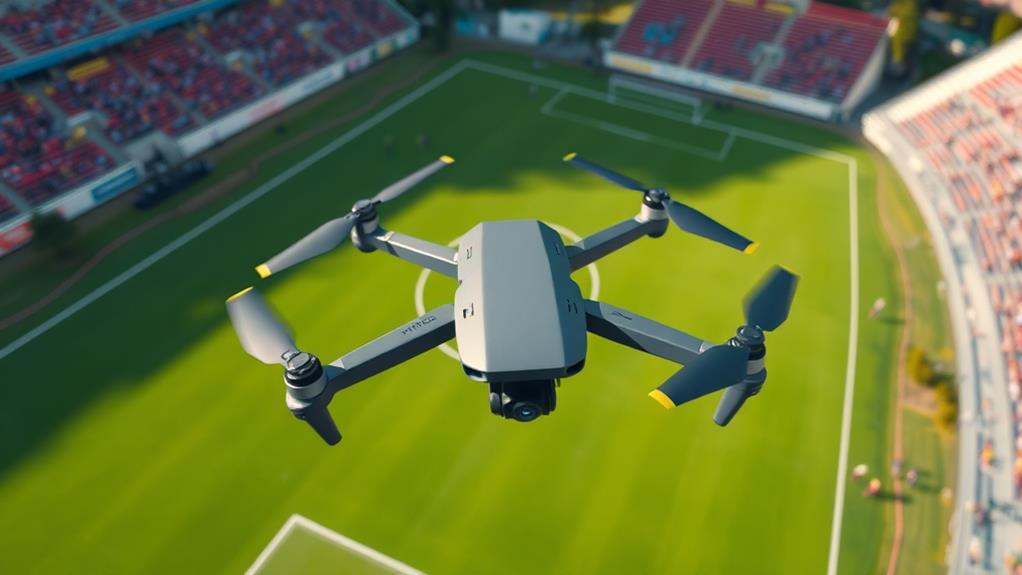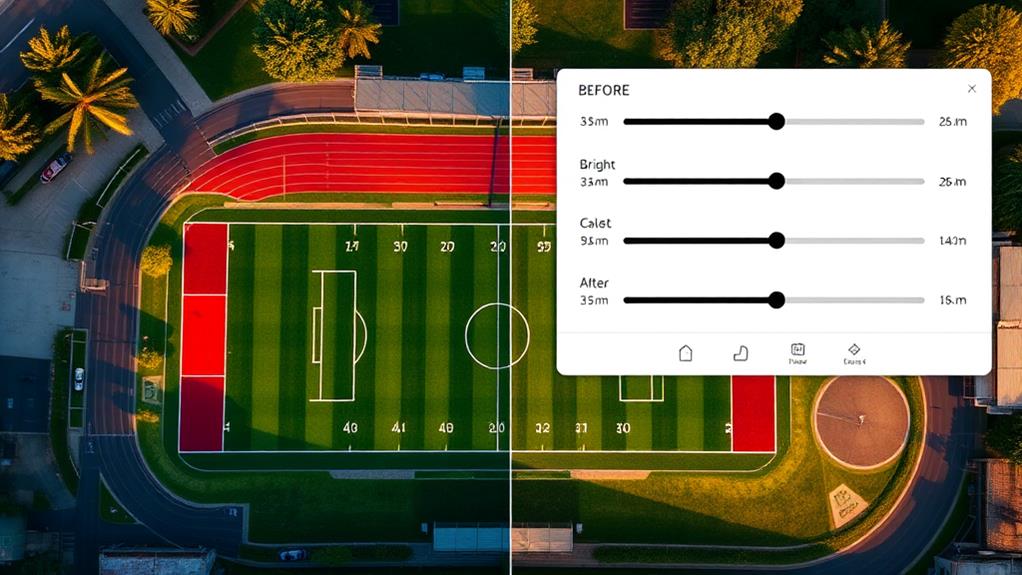To capture stunning sports drone photography, start by optimizing your lighting conditions, aiming for the golden hour or overcast days. Next, utilize dynamic flight patterns, like circling and tracking shots, to create engaging narratives. Mastering drone controls is essential, so practice in open spaces to build your confidence. Experiment with angles for unique perspectives, from bird's-eye views to low shots that focus on athletes. Finally, enhance your images in post-processing by adjusting exposure and applying color grading for emotional impact. By applying these techniques, you'll achieve high-quality results that stand out. There's so much more to explore!
Optimize Lighting Conditions

Lighting plays an essential role in sports drone photography, and refining it can make a considerable difference in your shots. The best lighting conditions occur during the golden hour—shortly after sunrise or before sunset—when sunlight is soft and warm. This natural light enhances overall image quality, making your drone photography stand out.
Overcast skies can also work to your advantage, providing diffused lighting that reduces harsh shadows and glare. This even exposure is especially beneficial when capturing dynamic moments in sports events.
However, avoid shooting in direct midday sunlight, as it often results in overexposed highlights and unflattering shadows.
To manage exposure in bright conditions, consider using ND (Neutral Density) filters. These filters reduce the amount of light entering the camera, allowing for slower shutter speeds and smoother video footage.
Additionally, always monitor and adjust your camera settings, such as ISO and shutter speed, according to the changing lighting conditions throughout the event. Doing so guarantees prime image quality and prevents issues like noise and motion blur.
Utilize Dynamic Flight Patterns
To capture the thrill of sports, utilizing dynamic flight patterns is essential for your drone photography. By incorporating these techniques, you can create engaging and immersive views that highlight the action from various angles.
Here are some effective strategies:
- Orbiting: Fly your drone in a circular path around the subject to showcase the excitement of the sports event from all sides.
- Diagonal or Zigzag Paths: Implementing these flight patterns enhances the perception of speed and movement, perfect for fast-paced sports.
- Altitude Changes: Experiment with flying at different heights. Mix overhead shots with closer perspectives to add depth and variety to your aerial photography.
- Tracking Shots: Follow athletes as they move to create a dynamic narrative that showcases their skills and the energy of the event.
Utilizing these dynamic flight patterns not only helps you capture everything but also guarantees your footage remains stable and clear.
By mastering the angles and movements, you'll elevate your sports photography and create visually stunning images that resonate with viewers.
Embrace the possibilities that drones offer, and watch your photography skills flourish!
Master Drone Controls

Mastering drone controls is essential for capturing high-quality sports footage. Start by familiarizing yourself with the drone's control sticks, which usually operate in a left (throttle and yaw) and right (pitch and roll) configuration. This setup helps you maneuver intuitively while flying.
To achieve better shots, customize the control sensitivity settings through the drone's app, allowing for smooth movements during your flights.
Practice is vital, so spend time flying your drone in open areas. This will build your confidence in managing altitude, direction, and speed before filming at sporting events. Always maintain a visual line-of-sight with your drone to comply with regulations and enhance your control over its movements.
Regularly reviewing the user manual and watching tutorial videos can deepen your understanding of specific features and techniques unique to your model.
Experiment With Angles
When capturing sports action, experimenting with angles can transform your footage into something truly mesmerizing. By trying out different angles, you can create unique compositions that showcase the action from various viewpoints.
Here are some tips to enhance your sports drone photography:
- Birds-Eye View: This overhead perspective can capture the entire scene, revealing patterns and movements that ground-level shots miss.
- Low-Altitude Perspectives: Flying close to the action isolates your subjects, reducing distractions and focusing attention on the athlete.
- Leading Lines: Incorporate lines in your composition to guide the viewer's eye through the image, adding depth and engagement.
- Rule of Thirds: Frame your shots by placing key subjects at grid intersections. This technique creates dynamic imagery and enhances visual interest.
Regularly practicing with these different angles won't only build your confidence but also improve your creativity as an aerial photographer.
Over time, you'll develop the skills needed to create impactful sports photography that captivates your audience.
Enhance Images in Post-Processing

After capturing stunning angles, the next step is enhancing those images in post-processing to elevate your sports photography. Start by utilizing editing software like Adobe Lightroom or Photoshop to adjust exposure, contrast, and saturation. This will help you enhance images and improve the overall quality of your drone shots, especially if you're working with RAW files.
Don't forget to apply noise reduction techniques during post-processing, particularly for images taken in low-light conditions or at high ISO settings, as this will greatly enhance image clarity.
Experiment with cropping and composition adjustments, following the Rule of Thirds, to create visually appealing and balanced photographs.
Additionally, consider using filters for drones during editing. Graduated filters can help balance exposure between the sky and the landscape, resulting in more dynamic images.
Finally, incorporate color grading techniques to enhance mood and atmosphere, ensuring your images convey the intended emotion and story of the sporting event.
Conclusion
By mastering these five techniques, you can elevate your sports drone photography from ordinary to extraordinary. Think of your drone as a painter, capturing dynamic moments on a canvas of sky and ground. With attention to lighting, flight patterns, control, angles, and post-processing, you'll create stunning images that tell a story. So grab your drone, embrace these tips, and let your creativity soar—turning every game into a visual masterpiece that captures the thrill of the action.

Leave a Reply